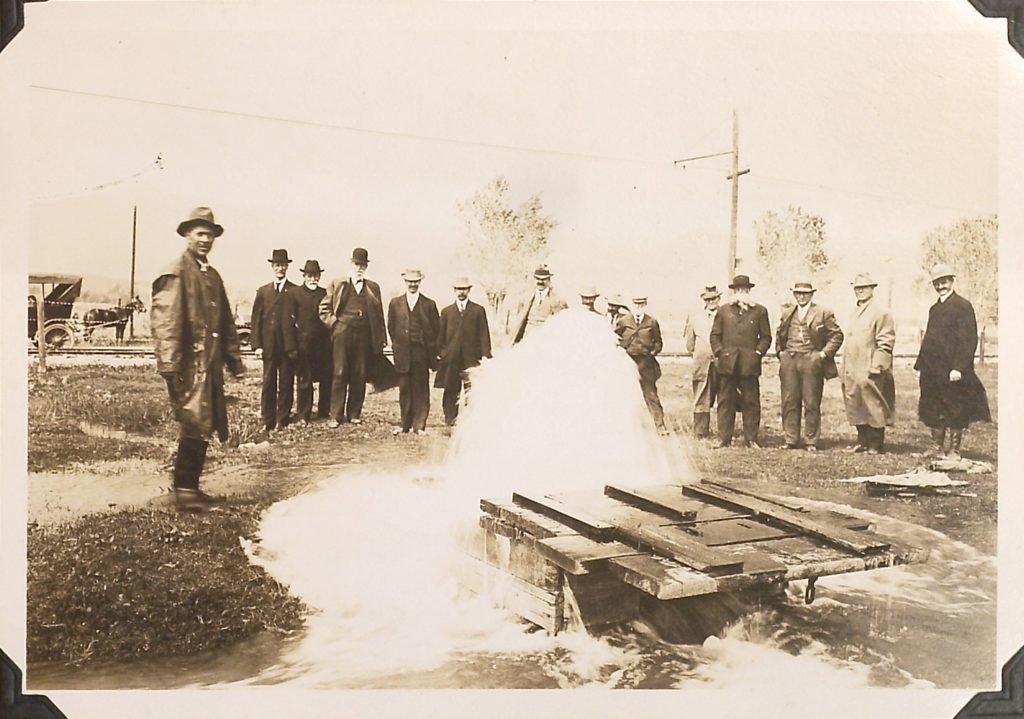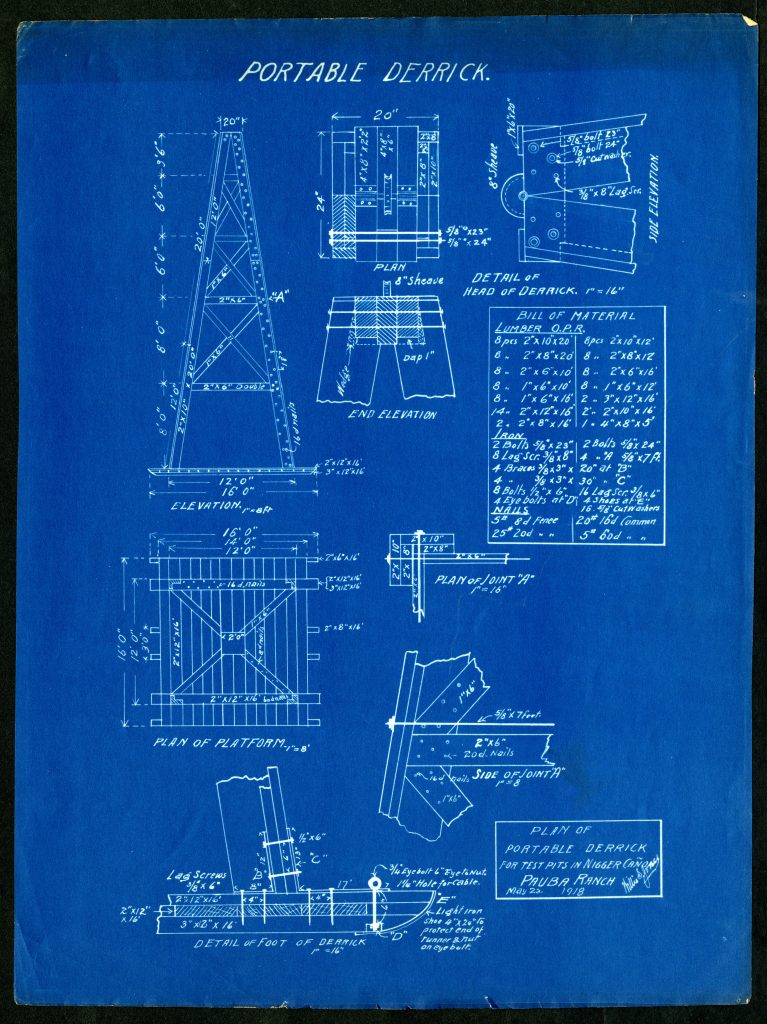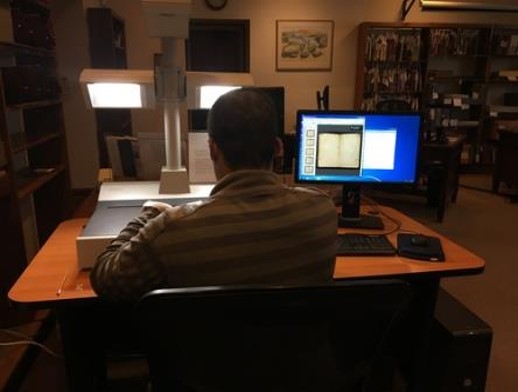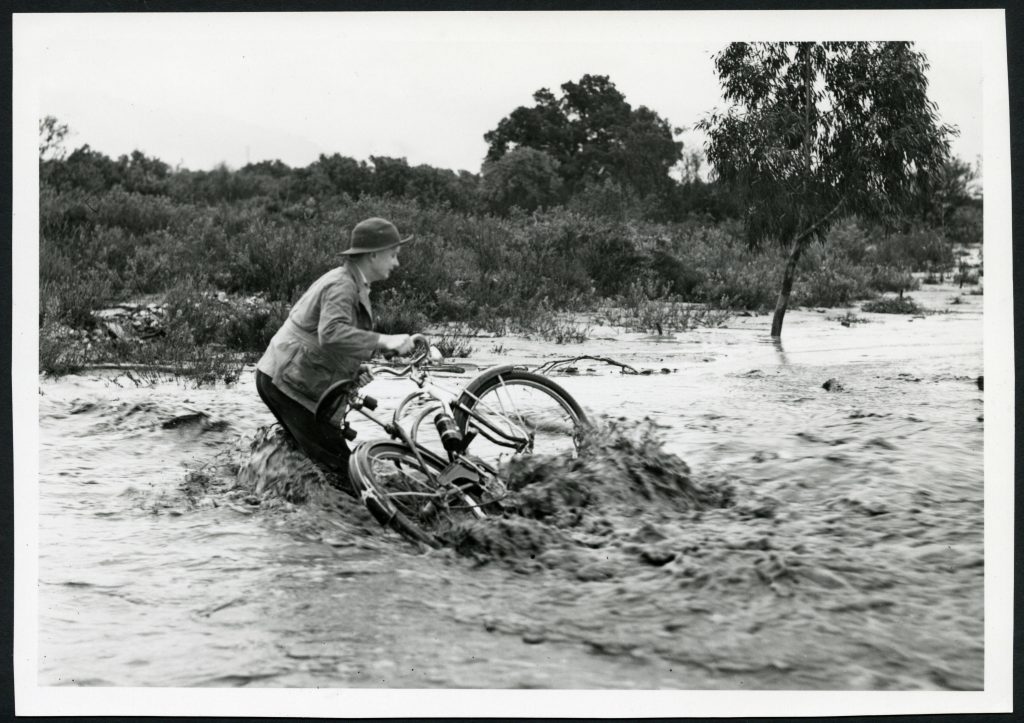1 Navigating the #CLIRWater Project
Lisa Crane
The 2021 Western Water Symposium is sponsored by The Claremont Colleges Library as part of the programming associated with our Council on Library and Information Resources (CLIR) Digitizing Hidden Special Collections and Archives grant. Our project’s official title is Digitizing Southern California Water Resources, but it is more commonly known as the hashtag #CLIRWater Project.
Conceiving the Project
When Special Collections at The Claremont Colleges Library first heard of CLIR’s digitizing hidden collections grant program, we immediately thought of our vast Water Resources collection. The collection, made up of many smaller collections, contains materials on the subject of water; its distribution, augmentation, and use in Southern California. Due to its size, it has pretty much defied complete cataloging.
The Claremont area and its surrounds have long had a “special” relationship with water issues. The city is located on a rather large aquifer that has been a source of water since the Tongva people first lived in the area. The city of Ontario, California is one of the few cities that gave water rights to landowners when they purchased a parcel in the booming city.

Our region’s experiences with water in the past, and the recent impacts of climate change, have direct implications for many other regions on a global scale. For example, with rising urban expansion and shrinking agricultural lands, Egypt seeks to farm the Sahara Desert. China, with the Yangtze River, and India, with its principal Eastern rivers, are attempting feats of engineering that were present in California more than a century ago, as engineers rebuilt water catchments and mapped and pumped groundwater for agriculture, housing developments, and industrialized civilization.
To create this multi-party collaborative project and bring together physically dispersed collections into a common digital space, we reached out to local organizations which held similar or complimentary water collections to our own. We ended up partnering with California State University, Northridge (CSUN) and California State University, San Bernardino (CSUSB), which are academic institutions; municipal public libraries Upland, Ontario (California), and the A.K. Smiley in Redlands; and the National Archives at Riverside (NARA), a federal government organization. Pomona College and its Foundation Relations and Strategic Initiatives team agreed to be the applicant institution.
Scope and Content
Over the past three years, the seven partner institutions collectively have digitized a critical mass of primary source documentation on the development, management, and exploitation of Southern California water and western US water held in our institutions. We have created a digital archive, accessed through the Western Water Archives (https://westernwaterarchives.org/) online portal, that supports, and hopefully inspires, scholarship through multiple disciplinary lenses, including public health, engineering, urban planning, legal history, and the array of disciplines that fall under environmental studies.

As these water documents have been digitized, scholars and students have had immediate access to a rich collection of maps, technical reports, financial documents, photographs, correspondence, and printed ephemera. Taking advantage of digital visual and computational tools, researchers can more quickly identify connections and patterns in the records, and more easily share their findings through this evolving, iterative, and interactive digital environment. We hope this project is a model for other water collections to employ digital tools that support and enhance questions contemporary scholars and researchers can ask and answer.
Digitized under the #CLIRWater Project and represented in the Western Water Archives are 23 archival collections from the seven institutions. Noteworthy individuals include George Chaffey, Frederick (Fred) Eaton, Charles Frankish, Willis S. Jones, William Mulholland, Charles N. Perry, Jeffry Joseph Prendergast, J. Ralph Shoemaker, and Frank E. Weymouth.
Significant organizational archives include the Bear Valley Irrigation Company, the Bear Valley Mutual Water Company, California Department of Water Resources, Department of the Interior’s Office of the Regional Solicitor in Los Angeles, Feather River Project Association, Metropolitan Water District of Southern California, Ontario Land and Improvement Company, Pomona Valley Protective Association, Salton Sea Authority, San Antonio Water Company and the US Geological Survey’s Hydrographic Branch.
Logistics
Students were hired at CSUN and CSUSB to digitize their respective materials. Because the Claremont Colleges Library had an existing digital production lab, and some of our smaller partners lacked equipment and expertise, Claremont hired students to digitize and describe the remaining partners’ materials. As a federal agency, NARA could not hire students or staff on their payroll, so we planned to include NARA under Claremont’s umbrella. A data dictionary was created and shared with partners to standardize the metadata and include appropriate intellectual property statements from each partner and file naming schemas were negotiated to minimize partners’ adjustments from their traditional file naming practices. We designed the tracking system using material checkout forms to move materials from the public libraries to Claremont and back. All digital objects created by CSUN, CSUSB, and Claremont would go into the California Water Documents collection of the Claremont Colleges Digital Library. Those that had their own digital asset management systems could also put their files into their own systems.
Student Collaborators
Beginning in March of 2017 through February of 2020, students from Claremont as well as students from CSUN and CSUSB, scanned, photographed, and converted analog audio cassette tapes, and created metadata, for a selection of materials from 26 archival water collections. Students were trained to handle historical documents, utilized an array of scanners and conversion software, created a variety of file types, described the digital objects using Dublin Core metadata schema, and uploaded their work into a digital asset management system for discovery by researchers worldwide.

Students from Claremont were hired under the library’s Claremont Center for Engagement with Primary Sources (CCEPS) as CLIR CCEPS Fellows. In addition to the technical aspects of the project, CLIR CCEPS Fellows were also tasked with writing a weekly progress brief, creating a weekly blog entry for the CCEPS blog “Out of the Box.” (http://blogs.libraries.claremont.edu/cceps/) and writing social media posts. They also shared their experiences with the fellowship in a culminating presentation to library staff, project partners, faculty, and their invited guests.
Challenges

As with most projects, you’re going to encounter challenges. When we wrote the grant proposal, we used prevailing wage and fringe benefit information available at the time. About the same time, California passed the law raising the minimum wage over the next six years starting in January 2017. So right at the start of the project, we had to adjust our budget to allow for the higher wages. When you have a fixed amount of funding and the cost increases, the total number of hours available to work goes down; as do your production yields.
About 18 months into the project, The Claremont Colleges Library underwent some organizational changes with the departures of the Dean, the Director of Digital Technologies and Library Systems (DTS), and the Associate Dean over a three-month period. The new director of DTS was instrumental in forming a new division within the library called Digital Strategies and Scholarship (DSS) and digital production was moved from Cataloging and Technical Services to the new division. There was a lot of downtime during this period as equipment had to be moved and reconnected and staffing for the new unit had to be hired. Newly hired staff encountered learning curves regarding student hiring practices at the library and working with the existing digital asset management platform, CONTENTdm.
We originally planned to hire three cohorts of CLIR CCEPS Fellows per year – one in the Fall, one in the Spring and one in the Summer – because we wanted to provide more job and learning opportunities to more students. But the hiring process took too long and the varied learning curves understandably affected production. We stopped this practice after the first year and decided to keep students on the project as long as possible.
When we calculated the budget and deliverables for the grant proposal, we didn’t plan enough time for non-production hours such as the weekly blog posts and culminating presentations. And, of course, with many students, life happens, and school happens, which take priority over work and production hours were further curtailed.
Our partners also posed additional challenges. In the matter of travel time, we did not fully consider the distance between partners. Claremont, Upland, and Ontario are centrally located near each other. CSUN is about 55 miles west of Claremont, NARA is about 40 miles southeast and Redlands and San Bernardino are about 35 miles to the east. The drive time varied from 40 minutes to more than an hour, traffic allowing (and it rarely does). It was difficult to hold meetings in person and since this was pre-pandemic years, Zoom wasn’t even on our radar. Finding students willing and able to travel to NARA was near impossible.
Conflicting digitization and availability policies created unnecessary delays. Coordinating and moving materials between Claremont and the public libraries posed physical custody challenges. Working with the large CSU schools, we found ourselves working with Enterprise Services, instead of payroll accountants or other financial staff to generate invoices. These individuals are so far from the project that it took a lot of work to get the correct information. The larger CSU schools also required descriptive metadata to be created by librarians and/or other metadata specialists, instead of the students digitizing the materials, as was done in Claremont. Despite the presence of a data dictionary and file naming schema, organizations with different digital asset management systems presented their metadata and files in non-conforming formats which required extra work on our part to standardize.
Achievements
All these challenges aside, as we came to the end of the grant period in February 2020, we have been delighted by what the seven institutions have achieved. We have successfully digitized 26 collections, either partially or completely, of the 31 collections we set out to digitize, resulting in over 137,700 pages and images scanned, and over 12,800 digital objects created. More than 10,000 new or enhanced metadata records were produced and almost 4,000 new controlled vocabulary or authority records are created.
Additional online content includes over 180 social media posts and over 300 blog entries. One measure of this work’s impact is that the California Water Documents collection in the Claremont Colleges Digital Library has had over 50,000-page views between March 2017 and February 2020.
Future plans
Although the pandemic put a stop to the flow of files from our partners, as Southern California begins to reopen and staff is allowed back to their offices, we expect to resume receiving files digitized pre-pandemic to be added to the collection and work funded under the #CLIRWater Project will also resume. Beyond the grant funding, The Claremont Colleges Library will continue to digitize its water archives and add to the collection as resources allow.

One of our crowning achievements of the #CLIRWater Project was the development of the Western Water Archives (https://westernwaterarchives.org/) portal, which was launched in Summer of 2020. I’m hoping some of you were able to dip into the Western Water Archives website when you registered for this symposium. If not, take a few minutes to do so. Perhaps you might even bookmark it, and as an additional resource for you.
Currently, you’ll find more details about the contributing partners, the collections digitized under this grant, and the CLIR CCEPS program. Collection titles are hot-linked so that a single click will bring all the items digitized from that collection to your results page. There are pages addressing conditions of use and accessibility, and you can easily contact The Claremont Colleges Library using the form at the bottom of the pages.
We will be adding additional pages to the Western Water Archives portal. The culminating presentations from the CLIR CCEPS Fellows will be added to the site. A digital toolkit page will offer the project data dictionary, training materials, forms, and non-proprietary grant application materials. A scholarship page will contain project-related presentations and workshop materials from the 2018 American Society for Environmental History annual meeting, student posters from the Western Water Archives Poster Showcase to be held this Spring and in the Fall, and ideas for course assignments; just to name a few scholarly examples. Of course, the recording from today symposium will also be available through the site. We are open to suggestions from any of you as well.
Our goal is simple: We want the Western Water Archives to be an abundant, even overflowing, water resource for students, faculty, and researchers worldwide.

